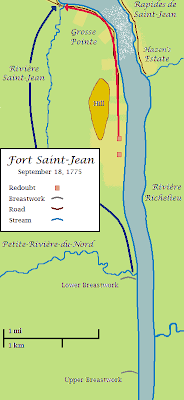On September 17, 1775, the Americans advanced on Fort Saint-Jean, in southern Canada, for the third time. Unlike the earlier attempts (September 6 and September 10), this time the British offered no outward resistance. The Americans took up positions to the south and northwest of the fort, which placed the garrison in a state of siege. Early on September 18th, the British garrison learned of its predicament. Lieutenant William Duff of the 7th Foot was dispatched with about 30 Canadian volunteers to round up cattle from farms north of the fort and to scout out the American position to the northwest. Also, Guillaume de Lorimier, with a few Indians, was sent to scout out the American position to the south.
When Duff returned to the fort, he reported that the American force to the northwest was small, and the fortification it had erected was crude. Major Preston then dispatched Captain John Stronge with around 100 men of the 7th and 26th regiments, with nearly as many Canadian volunteers, and a field piece to drive away the Americans. The force they attacked was much smaller: about 50 Americans and 34 Canadians under the command of Major John Brown.
Brown’s men fired as the British approached, killing Sieur Beaubien dit Desauniers of the Canadians and wounding Corporal Knowles and Private Kelly of the 7th. The British, for their part, fired and charged. This fire possibly wounded several of Brown’s men, who quickly fled into the woods. [1]

Canadian Antoine Dupré was the first man to climb into the breastwork; there he captured a couple of men, including Moses Hazen, a retired British officer and a prominent local landowner.
Hazen had been Brown's prisoner; he was captured the day before while traveling to his fields. However, the British suspected the worst of him and kept him as their own prisoner. The suspicion was deserved. Hazen had secretly contacted the Americans on September 6. On September 11, the British gave him a captain’s commission and orders to raise a company of militia. He did neither.
The British sortie against Brown’s command surprised the American leadership. Brigadier-General Richard Montgomery had intended Brown’s position to remain secret until he could move 500 men into position to support him. However, Brown was defeated before the American movement began. As soon as the sound of musket fire boomed across the flat woodland, Montgomery raced to get his forces into motion.
On the river, the Schuyler and Hancock rowed towards the fort and opened fire with their 12-pounders. This fire reportedly struck a bateau and the British schooner, the Royal Savage, but apparently did no other harm. The British responded with shell fire, but they, too, were unable to inflict casualties.
On land, Colonel Timothy Bedel led around 500 men from Bedel’s Rangers (his regiment), the 4th Connecticut, and the Green Mountain Boys, on a circuitous march through the wet woodland north and west of Saint-Jean. En route, Bedel received conflicting advice: a Canadian guide wanted to take Bedel directly to the site of the earlier skirmish, while a Huron guide wanted to take Bedel further to the east, so as to cut off the British detachment from the fort. Bedel, not understanding the Indian’s intention, and fearing treachery, took the Canadian’s advice.
 Skirmish at Rivière Saint-Jean (click to enlarge). The British attack is shown in red. The advance of the American relief force is shown in blue.
Skirmish at Rivière Saint-Jean (click to enlarge). The British attack is shown in red. The advance of the American relief force is shown in blue.
The Americans advanced noisily through the woods, and the British opened fire the moment they came into view. According to Lieutenant John Fassett of Vermont, “They gave us a hot fire. The grape shot and Musket balls flew very thick…”
 Bedel's Column Forms for Battle.
Bedel's Column Forms for Battle.
Benjamin Trumbull (who at the time was in the main American camp), claimed that the British fire wounded two Americans (including a Captain John Watson of the 4th Connecticut), and that a piece of grape shot accidentally killed one Briton (that would be, based on other evidence, Private Alexander Ross of the 26th). Before the Americans could deploy, the British scrambled for the safety of their fort. Bedel then occupied the breastwork Brown had built.
Once again, Fort Saint-Jean was in a state of siege.
Note:
1. See this letter from Major Israel Morey to the New-Hampshire Committee of Safety.
No comments:
Post a Comment